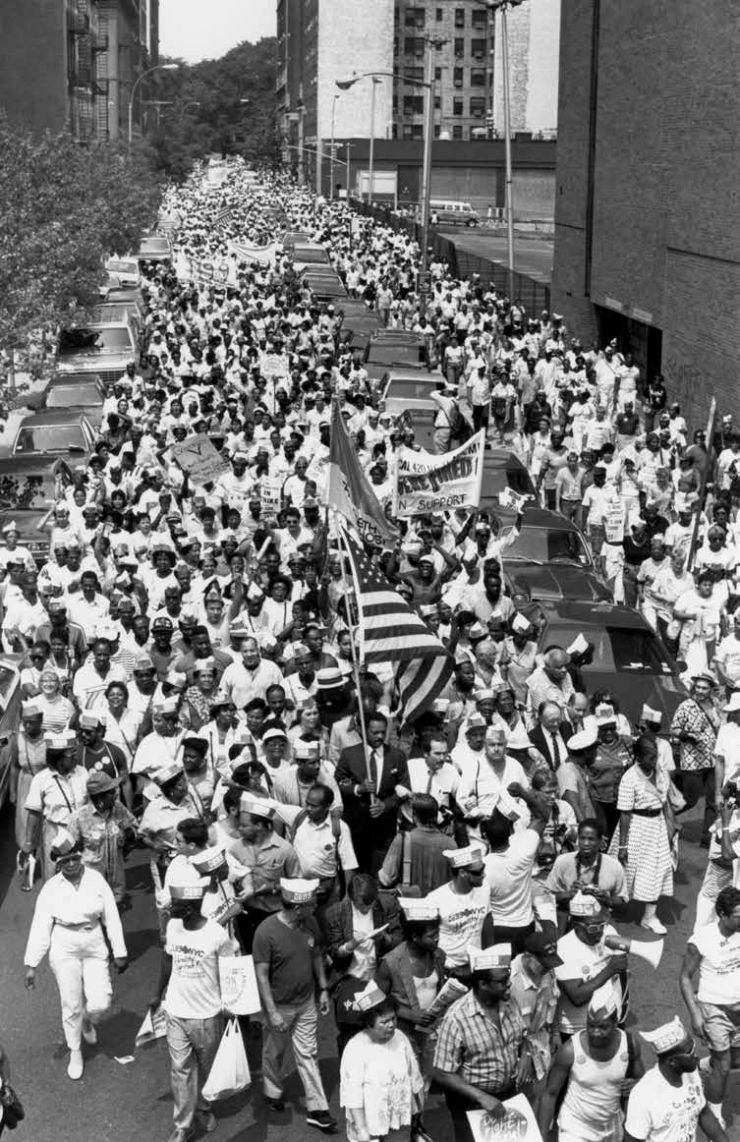LEAGUE CONTRACTS HAVE BEEN THE CENTERPIECE OF UNION'S GROWTH
July 27, 2021
Rank-and-file leadership has been key ingredient.

For workers who less than a decade earlier earned as little as $32 per week, the Union by 1968 was strong enough during League negotiations to demand a living wage. At a June 27 strike rally that year, members voted overwhelmingly to stage work stoppages to press their demands at the 40 League hospitals. Just hours before a July 1 strike deadline, all night negotiations produced the $100-a-week settlement. The pact marked the end of full-time hospital work for part-time pay.
The 1970s presented further challenges. The Union won generous wage increases in 1970 and 1972. But under President Richard Nixon’s anti-labor campaign to curb inflation, all labor settlements required federal approval. The two 7.5 percent contract increases exceeded the 5.5 percent allowed under federal guidelines.
In April 1973, the federal government agreed to the first year’s increase, but not the second. The Pay Council had agreed to rule later on the second year’s increase, but failed to meet two agreed-upon dates. On Nov. 5, some 30,000 Union members walked out of 48 voluntary hospitals, and one week later, the Council agreed to a 6 percent increase. Members accepted the compromise.
Although they had not won the full increase, 1199ers could proudly claim that they were the only workers in the nation to defy the Nixon board.
By 1978, a united negotiating committee and membership were committed to “catch up with the cost of living.” They did so by winning a 14.5 percent increase over two years. But around the same time, hospitals instituted sharp cutbacks. Job security became a top priority.
Sadly, President Leon Davis suffered a heart attack in 1979, and the leadership was forced to confront two thorny issues – choosing Davis’ successor and deciding whether to merge with the Service Employees International Union (SEIU) for increased support.
The successor and merger issues led to deep divisions. Under President Davis’ successor, Doris Turner, members were led out on a disastrous 47-day strike in 1984. A divided and weakened Union was forced to accept an inferior contract.
With the victory of the progressive Save Our Union slate in 1986, the Union – still not yet fully united – was able to win modest contract gains that year. The leadership used the ensuing period to train and reconstitute the delegate body. Some 4,000 contract captains were recruited to assist delegates for the 1989 negotiations. The leadership decided to test the members’ resolve with a series of rolling strikes.
The turnouts were overwhelming. Each action saw about 40,000 members take to the streets. The contract was settled hours before an Oct. 4 strike deadline. Workers won improvements in vacations and benefits, plus whopping raises of 21.6 percent over four years. The Oct. 8 edition of The New York Times heralded the Union’s revival with the headline, “Local 1199 Is Back. The Hospital Workers Are the Envy of Labor Now.”
During the 1990s, the Union leadership was finally able to heal divisions and fortify the delegate body. The 1998 League negotiations reflected the improved relationship between the leaders and members. When President Dennis Rivera asked to postpone a scheduled Madison Square Garden rally after contract talks had broken off, negotiating committee members disagreed. Pres. Rivera listened and then called for a vote, making it clear that the committee members – the eyes and ears of members in the workplace – had the last word. The committee voted overwhelmingly to go ahead with the rally, and it was a resounding success. The one-year campaign with many spirited mass mobilizations won greatly improved job security and benefits, early retirement and wage increases.
After the 9/11 attacks in 2001, 1199 and the League agreed to extend the existing contract. Negotiations were held the next year, during a severe economic downturn in 2002. Mass mobilization again led to victory.
A key component of the 42-month contract was an expanded employment security package that covered almost three-quarters of members in League institutions. The pact also included pension increases, employer neutrality in organizing, the best family healthcare plan in the nation, and an April 30 expiration date that coincided with the expiration date for 1199 nursing home members. “This contract is the best argument for our Political Action Fund,” said Audrey Gomez, a unit clerk at Brooklyn’s Brookdale Hospital. “Our political strength made this settlement possible.”
In 2005, unemployment was up sharply nationwide, including in New York. Before League negotiations began, members cited three major concerns: job security, maintenance of healthcare benefits with no outof- pocket expenses, and a decent wage increase in each year of the contract. Once again, employers understood that 1199ers were united and were ready to fight to the end for a fair contract. Employers also came to appreciate the importance of partnering with the Union to secure necessary funding.
In 2009, with President George Gresham leading negotiations, the economy was in even worse shape, but members again rallied behind the slogan “Save Our Benefits for Our Future.” And they did. “I came to 1199 because of the benefits and pension,” said Nicholas Denesopolis, a receiving clerk at Manhattan’s Lenox Hill Hospital and a member of the negotiating committee. “I just want some security, and we got it in this contract.”
In 2015, members responded to the League take back demands with walk-ins, button-up days and a June 18 League-wide informational picketing. Said members on the picket lines, “We don’t want to strike, but we will if we have to.”
Members not only saved their benefits, but also won increases totaling 13 percent over the life of the four-year pact.
In 2018, members faced similar resistance from management, particularly from nursing home owners. Again, tens of thousands of 1199ers flooded the streets near League institutions chanting, “To Win This Fight, We Must Unite!” A subhead in the July-August 1199 Magazine hailing the many contract gains read, “To win this fight we DID unite!”
1199 Magazine - May / June 2021

